"7x7" report
Photo by Gleb Paykachev
Photo by Gleb Paykachev
Bears, grass and surrealism – what bloggers saw on the oil spills near Usinsk
Blog tour in Usinsk. Part 1. Oil
One of the major problems associated with oil spills is the problem of misunderstanding. People who see oil spills and understand their danger live somewhere in the distant forests, wetlands, tundra, where Mother-oil is pumped from the most beloved homeland subsurface. But we must admit that most of the citizens of our country rich in hydrocarbons either know nothing about the problem of oil pollution, or understand only vaguely. This doesn't only occurs not because of a cover up of the problem. Something is covered up, of course, but in recent years a whole variety of media has been speaking about the oil spills: writing article and shooting videos.
However, the problem does not resonate with the community, whether by virtue of indifference, mastered by people, or because of the acute social problems that always seem to be more important. There is no thought for the oil spills in the distant forests, tundra and bogs (who lives in such places anyway?), when a variety of local problems dominate one's attention.
However, the problem does not resonate with the community, whether by virtue of indifference, mastered by people, or because of the acute social problems that always seem to be more important. There is no thought for the oil spills in the distant forests, tundra and bogs (who lives in such places anyway?), when a variety of local problems dominate one's attention.
Reason for choosing oil spills as a theme of the blog tour
Oil companies continue to work dirtily, officials continue to turn a blind eye to anything. So why should we bring it up again? Inhabitants of the village of Kolva might ask this question; for many years they suffered from oil pollution, we even have a whole column on it. They usually react the following way: we'll tell you everything, many others wrote about it before you, but nothing will really change.
So is it all so hopeless? Perhaps there is some small progress at least? Perhaps a more effective platform to combat environmental pollution has been formed like a pat of butter under the legs of frog who did not want to die floundering in a jug of milk? We are returning to the subject once again to try and understand it, but there is another reason: if you do not occasionally shake society, it will simply sink into a deep sleep. Sort of like a man sleeping in freezing cold snow who, with time, will eventually not awake from his frozen slumber.
Oil companies continue to work dirtily, officials continue to turn a blind eye to anything. So why should we bring it up again? Inhabitants of the village of Kolva might ask this question; for many years they suffered from oil pollution, we even have a whole column on it. They usually react the following way: we'll tell you everything, many others wrote about it before you, but nothing will really change.
So is it all so hopeless? Perhaps there is some small progress at least? Perhaps a more effective platform to combat environmental pollution has been formed like a pat of butter under the legs of frog who did not want to die floundering in a jug of milk? We are returning to the subject once again to try and understand it, but there is another reason: if you do not occasionally shake society, it will simply sink into a deep sleep. Sort of like a man sleeping in freezing cold snow who, with time, will eventually not awake from his frozen slumber.
On July 6-8, 2016 experts of Greenpeace Russia with the informational support of «7x7» organized a trip to the small town of Usinsk, Komi Republic, so that bloggers, who could write, take photos and film in the region were able to see oil spills with their own eyes and then talk about them.
Ten people from seven cities of Russia visited the place of the oil spills, found out about the threat it poses, also how people lived here side by side with the spilled oil, as well as about relations between the administration, oil companies and the local population.
Ten people from seven cities of Russia visited the place of the oil spills, found out about the threat it poses, also how people lived here side by side with the spilled oil, as well as about relations between the administration, oil companies and the local population.
"Approach to the President"
On the evening of July 5, Usinsk. It's quite warm, even stuffy. We arrived in Usinsk by train, dropped our things into a rented apartment and along with the Greenpeace expert Elena Sakirko went to the local branch of the Ukhta State University (Ural State Technical University), in hope of agreeing on a room for the lecture.
Usinsk became a town in 1984 and was built as a one large suburb. Visually, it is monotonous: typical five- and nine-storey buildings everywhere, typical schools and kindergartens. Once there was even a Komsomol construction, one of the last in the Soviet Union, and people thought about the functionality a lot, and a little about architectural excesses. Maybe there was not enough money for beauty, or maybe even functionality itself was seen as beauty. Lena suggests that it was too difficult psychologically: 'There is no historical part of the city, where you can go for a walk'. I think that there are advantages: no out of place buildings, a lot of open space, you can look at the clouds in clear days like this one.
The city is cozy and even bright for local residents (maybe because of the habit of dyeing prefab houses in different cheerful colors?). They can easily be understood if we go, for example, to Pechora, with its historical part and old buildings and to estimate the number of old and dilapidated housing stock. Usinsk has no architectural history, but there is no chaos.
Usinsk became a town in 1984 and was built as a one large suburb. Visually, it is monotonous: typical five- and nine-storey buildings everywhere, typical schools and kindergartens. Once there was even a Komsomol construction, one of the last in the Soviet Union, and people thought about the functionality a lot, and a little about architectural excesses. Maybe there was not enough money for beauty, or maybe even functionality itself was seen as beauty. Lena suggests that it was too difficult psychologically: 'There is no historical part of the city, where you can go for a walk'. I think that there are advantages: no out of place buildings, a lot of open space, you can look at the clouds in clear days like this one.
The city is cozy and even bright for local residents (maybe because of the habit of dyeing prefab houses in different cheerful colors?). They can easily be understood if we go, for example, to Pechora, with its historical part and old buildings and to estimate the number of old and dilapidated housing stock. Usinsk has no architectural history, but there is no chaos.
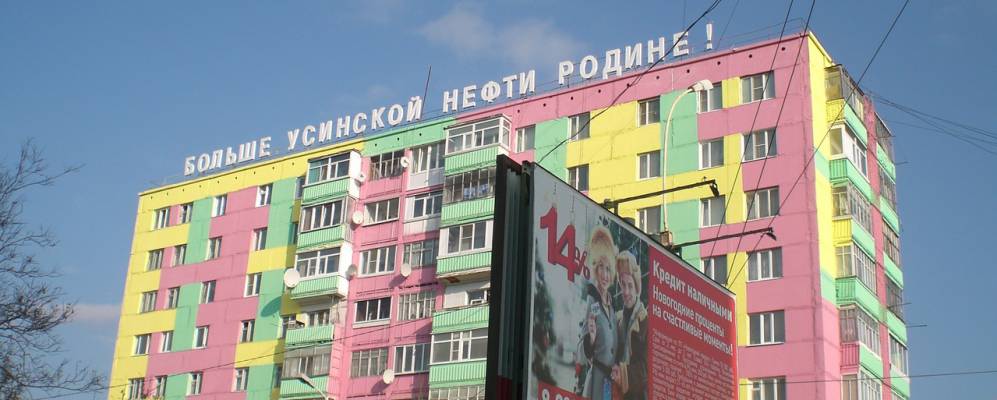
Photo by komandirovka.ru
Visitors see the Komsomol enthusiasm on the first visible banner. "More Usinsk oil to the homeland!" looks as if the Soviet Union is still in good spirits and full of energy. From the new, if you wander around the city: striking gleaming glass and metal of oil company offices, a four-star hotel "Polar Star" and two monuments – to the oiler and a mosquitoe. The mosquitoe is quite cute, the oiler not so much.
Reason for choosing Usinsk as a location of the blog tour
The choice was obvious – Usinsk is called the oil capital of Komi. And oil is extracted with all the consequences (in the literal and figurative sense), with the largest onshore oil spill occuring near Usinsk in 1994. A major role was also played by the fact that the experts of Greenpeace Russia have been here many times, and had held Oil Patrol only two years previously. Then a large number of oil pollution was found, and there was a need to check the cleaning efforts.
The choice was obvious – Usinsk is called the oil capital of Komi. And oil is extracted with all the consequences (in the literal and figurative sense), with the largest onshore oil spill occuring near Usinsk in 1994. A major role was also played by the fact that the experts of Greenpeace Russia have been here many times, and had held Oil Patrol only two years previously. Then a large number of oil pollution was found, and there was a need to check the cleaning efforts.
The branch of the University to which we are headed is located on the central square – close to the city administration and the offices of "Lukoil".
The building of the UGTU branch is empty – everyone has gone home. A janiter looks at us kindly, and helps us to reach one of the officers of administration. Seeing that Lena from Greenpeace is here, he lightens up:
'Does the state help you? You know, If I was president...' he sits back dreamily, 'first of all I would help the environmentalists. The President, he's kind of like the landlord, he should make sure the flat is clean, the everything's in order. Have you approached him about this? Approach him, he'll help. I would definitely help, were I in his shoes!'
It is slightly unfortunate that he is not the President. Arranging the room requires permission of administration in Ukhta, a request which can only be sent in the morning.
The building of the UGTU branch is empty – everyone has gone home. A janiter looks at us kindly, and helps us to reach one of the officers of administration. Seeing that Lena from Greenpeace is here, he lightens up:
'Does the state help you? You know, If I was president...' he sits back dreamily, 'first of all I would help the environmentalists. The President, he's kind of like the landlord, he should make sure the flat is clean, the everything's in order. Have you approached him about this? Approach him, he'll help. I would definitely help, were I in his shoes!'
It is slightly unfortunate that he is not the President. Arranging the room requires permission of administration in Ukhta, a request which can only be sent in the morning.
The first day. Lecture
'I actually did not see field developed by all the rules'
The morning of July 6, all the participants of the blog tour gather in one of the rented apartments for a study lecture on oil spills by the head of Greenpeace Russia's research program Vasily Yablokov. It is 28 degrees Celsius outside, a mower is buzzing in the yard.

Vasily Yablokov
The head of Greenpeace Russia's research program
'Many believe that oil is a natural object,' says Vasily, 'But the stratosphere is also a natural object, and just try to breathe in it. In this region, oil is sour crude, its vapors are dangerous to humans. An even greater danger is posed by the water reservoir.'
'It is the liquid, which is in the reservoir together with the oil. A flood of such water is like a flood of acid, it destroys all living things.'
If the oil remains on the surface for a long time, it decomposes and becomes a kind of asphalt. An "asphalt" forest will die.
'It is the liquid, which is in the reservoir together with the oil. A flood of such water is like a flood of acid, it destroys all living things.'
If the oil remains on the surface for a long time, it decomposes and becomes a kind of asphalt. An "asphalt" forest will die.
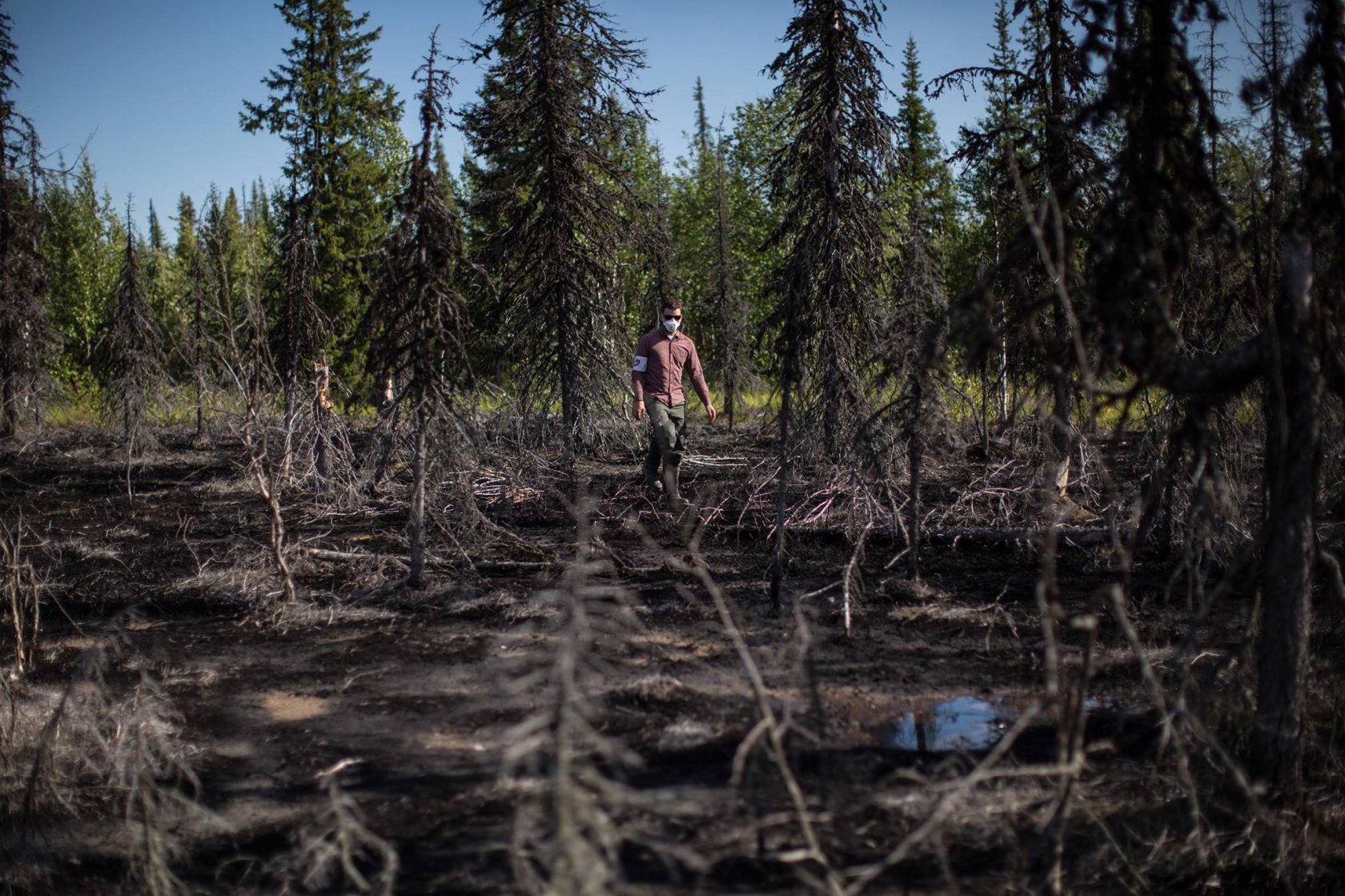
Photo by Denis Sinyakov, Greenpeace Russia
Often, the oil companies while cleaning up after themselves will either re-cultivate the land poorly or sometimes not at all.
'A digged swamp looks epic. They plant lawns that are green in both summer and winter.'
The reason for a large number of spillages is ecological dumping. It's easier for mining companies to pay less than to change the old pipes and observe safety precautions. Moreover, the spill must first be found, and then proven that the company bears responsibility for it. Vasily Yablokov is sure that if fines were real, the oil companies would have to behave more responsibly. While high income is provided to them, they are in no hurry to invest in modernization.
'I have not actually seen the deposits developed according the rules. This is a legacy of extensive development since the Soviet times.'
Basically Greenpeace activists receive information about oil spills from satellite images. So two years ago they discovered numerous violations, 205 of them they managed to capture, take photos, and set the coordinates. Now bloggers need to do the inspection and form a response – to go through the previously detected spills and see how things are after two years, and then tell us everything that they saw.
'There is a myth that the territory and all that therein is under licensed areas owned by oil companies, but it is not true. This is property of the state, and therefore, it is owned by the people. Oilers are allowed to use subsoil. But they can not hinder citizens being in the woods.'
Vasily Yablokov finishes lecture by mentioning the region where the case with oil spillage situation is particularly bad:
'Khanty-Mansi Autonomous District is the black heart of our homeland.'
Suddenly we hear the street radio through the window. A woman's voice warns of high fire danger and that it is not recommended to go into the forest. But we're going to check the oil spill.
Background
2014, August. "Oil Patrol" near Usinsk was organized by "Greenpeace Russia". More than 40 volunteers from different countries were looking for oil spills and cleaning them for two weeks. A total of 205 sites with a violation of the oil extraction norms were found, including very old oil spills – the heritage of "Lukoil".
2015, July. The participants of the seminar on identifying environmental violations examined Usinsk oil field. They walked through the sites found the year before by "Oil patrol", and accross contaminated sites which social activists discovered in 2012. 'It's a fat slap in the face of the entire environmental system of the state,' member of Pechora Rescue Committee and blogger "7x7" Ivan Ivanov estimated an almost complete absence of cleaning work on sites.
2015, September. Republican commission on acceptance of contaminated lands was organized. This is a unique structure by Russian standards, which included not only public figures, but also, for the first time, a representative of Greenpeace. Including the results of nine "sites of Greenpeace" – a positive tendency in the elimination of prejudice were represented to Commission.
2016, July. Regular checks of the condition of sites with fixed environmental violations. Now the participants of the blog tour have been sent to inspect them.
2015, July. The participants of the seminar on identifying environmental violations examined Usinsk oil field. They walked through the sites found the year before by "Oil patrol", and accross contaminated sites which social activists discovered in 2012. 'It's a fat slap in the face of the entire environmental system of the state,' member of Pechora Rescue Committee and blogger "7x7" Ivan Ivanov estimated an almost complete absence of cleaning work on sites.
2015, September. Republican commission on acceptance of contaminated lands was organized. This is a unique structure by Russian standards, which included not only public figures, but also, for the first time, a representative of Greenpeace. Including the results of nine "sites of Greenpeace" – a positive tendency in the elimination of prejudice were represented to Commission.
2016, July. Regular checks of the condition of sites with fixed environmental violations. Now the participants of the blog tour have been sent to inspect them.
Spills
'In the 90s this lake would be set on fire with a black column of smoke, so thick that you could touch it.'
We sit in two minibuses, six passengers in each one – five bloggers and one expert from Greenpeace. The city quickly fades into the back ground. We open the windows because of the heat, and from time to time we can smell an unpleasant odor.
'This is hydrogen sulfide,' the driver says.
The distance is measured not in kilometers, but bridges. We need a second bridge. But first we pass over the suffering Kolva River. On our left it is blocked by stationary bon.
'This is hydrogen sulfide,' the driver says.
The distance is measured not in kilometers, but bridges. We need a second bridge. But first we pass over the suffering Kolva River. On our left it is blocked by stationary bon.
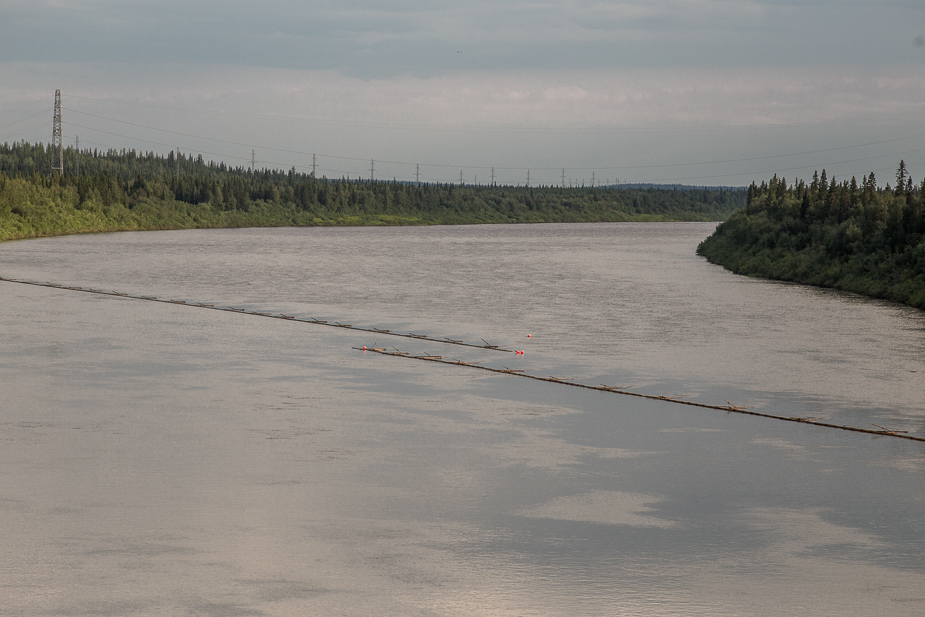
'It is expected to delay the oil, which is lighter than water and floats on the top,' Komi blogger Ivan Ivanov says. He is a member of the oldest and most influential environmental organization in Komi Save the Pechora Committee, and has been monitoring oil spills for many years.
After about an hour we turn onto a dirt road. We are going slowly, it becomes quieter, we can hear the birds singing. Inside, Ivan tells the other bloggers about the largest oil spill in 1994. The driver says:
'Oh, we rocked the whole world! I'll close the vents, or we will be eaten alive.'
Our minivan is struck by the hordes of flies. We stop near the broken bridge – it is impossible to go further.
After about an hour we turn onto a dirt road. We are going slowly, it becomes quieter, we can hear the birds singing. Inside, Ivan tells the other bloggers about the largest oil spill in 1994. The driver says:
'Oh, we rocked the whole world! I'll close the vents, or we will be eaten alive.'
Our minivan is struck by the hordes of flies. We stop near the broken bridge – it is impossible to go further.
Causes of oil spills
Burst pipes, because of which oil spills usually occur in the ground and on land, mainly in the inter-field pipelines with an oily liquid-mixture of water, oil and gas. Accidents occur due to the fact that companies continue to use the old pipes, although their service life has expired. Changing to new pipes is expensive. It is cheaper to repair a breakage and reclaim a small piece of land. Although in recent years the company more rapidly began to replace the pipes, but as long as the amount of work was small.
Burst pipes, because of which oil spills usually occur in the ground and on land, mainly in the inter-field pipelines with an oily liquid-mixture of water, oil and gas. Accidents occur due to the fact that companies continue to use the old pipes, although their service life has expired. Changing to new pipes is expensive. It is cheaper to repair a breakage and reclaim a small piece of land. Although in recent years the company more rapidly began to replace the pipes, but as long as the amount of work was small.
To the left of the road we see vertical pipe barrels brazened with "Lukoil" logos , and oil around.
'There's something strange with the barrel wells. There should be some here, but there isn't' the driver surprisedly remarks, looking out the window.
'There's something strange with the barrel wells. There should be some here, but there isn't' the driver surprisedly remarks, looking out the window.
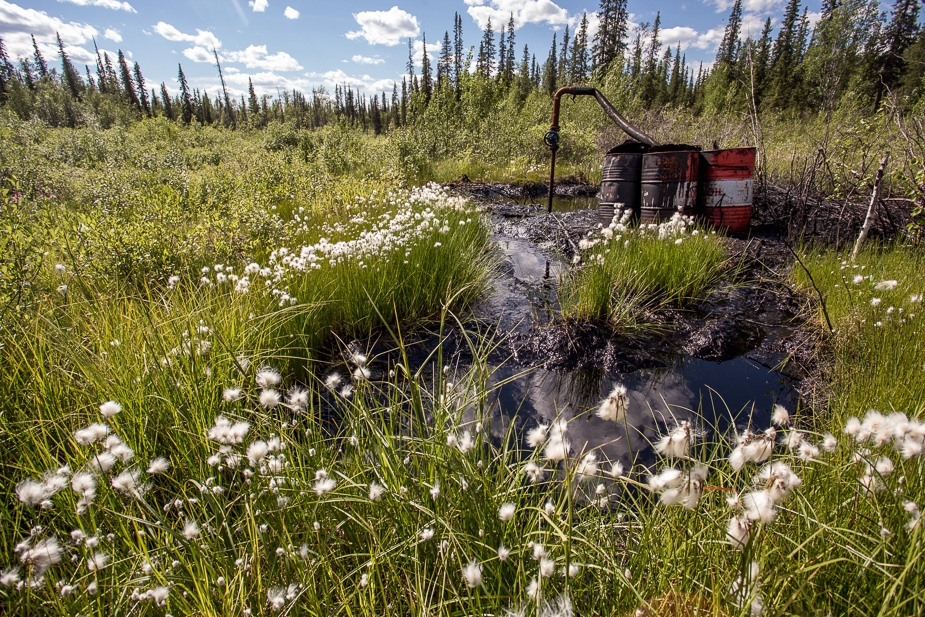
Vasily Yablokov also finds the object strange, though he is seeing it not for the first time:
'There is no production, there is no infrastructure, why is this pipe here?'
'This is an installation,' jokes one of the bloggers.
Coming out of the car and looking around, we go to the next site. Along the way, we encounter a bear trail. It is not fresh. The bear, judging by the paw prints, is small.
'We are are a large group,' says Vasily reassuringly. 'No normal animal will attack.'
However, no one looks frightened.
Next site is localized. It is a small puddle of oil with the burst pipe. Vasily says it is quite deep – a few meters. The area around it is sprinkled with sand, but oil leaked somewhere under the ground – an iridescent film floats in a large puddle nearby.
'There is no production, there is no infrastructure, why is this pipe here?'
'This is an installation,' jokes one of the bloggers.
Coming out of the car and looking around, we go to the next site. Along the way, we encounter a bear trail. It is not fresh. The bear, judging by the paw prints, is small.
'We are are a large group,' says Vasily reassuringly. 'No normal animal will attack.'
However, no one looks frightened.
Next site is localized. It is a small puddle of oil with the burst pipe. Vasily says it is quite deep – a few meters. The area around it is sprinkled with sand, but oil leaked somewhere under the ground – an iridescent film floats in a large puddle nearby.
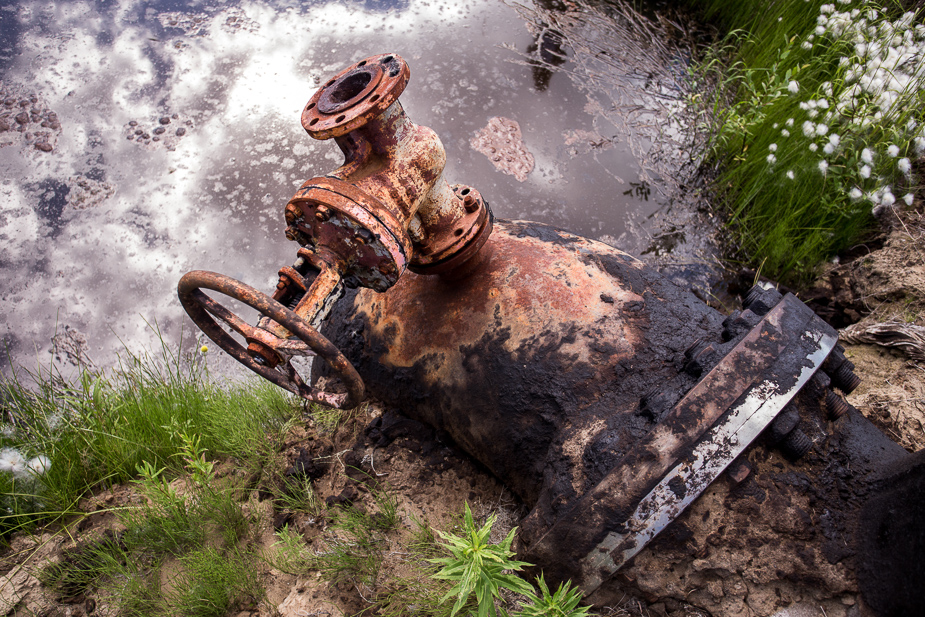
Cotton grass grows thickly
'Oil is not so poisonous for plants as reservoir pools,' Vasily says.
On the surface of the puddle you can see the so-called "squash caviar", which is formed when the reservoir water is mixed with organic matter.
A blogger, and our part-time photographer, Gleb Paykachev messed his trousers in the oil. When we sit down in the car to go on, Ivan Ivanov says that will now be impossible to wash these clothes, and the smell wouldn't erode for years.
'Oil and cat urine will never wash off,' confirms Alec Lun with knowledge of the matter.
Alec is a journalist from the United States, he has been living in Moscow for five years and writes for the Moscow Times and The Guardian.
'Oil is not so poisonous for plants as reservoir pools,' Vasily says.
On the surface of the puddle you can see the so-called "squash caviar", which is formed when the reservoir water is mixed with organic matter.
A blogger, and our part-time photographer, Gleb Paykachev messed his trousers in the oil. When we sit down in the car to go on, Ivan Ivanov says that will now be impossible to wash these clothes, and the smell wouldn't erode for years.
'Oil and cat urine will never wash off,' confirms Alec Lun with knowledge of the matter.
Alec is a journalist from the United States, he has been living in Moscow for five years and writes for the Moscow Times and The Guardian.
Problems with drilling waste
Often, instead of oil pits (a place which is dug in the ground, with concreted walls and floor, and covered with a roof, it is used to isolate the oil-containing liquid and to minimize its impact on the environment), construction of which is a complex and expensive process, they leave the oil pools. Some of them are decades old.
Often, instead of oil pits (a place which is dug in the ground, with concreted walls and floor, and covered with a roof, it is used to isolate the oil-containing liquid and to minimize its impact on the environment), construction of which is a complex and expensive process, they leave the oil pools. Some of them are decades old.
Our driver, meanwhile, assumed the role of tour guide.
'Here is a well,' the driver nods in the direction of a column with a valve sticking out of the ground, 'Also conserved since the Soviet era. There are many of them. And you will not be allowed up to them, you will need ATV motorcycles to drive around the posts.'
Vasily explains why we go to the unfenced areas, reachable by car.
On the next site, where we arrive, some oil is already being poured.
'Well, it is not an installation, it is a performance,' smiles one of the bloggers.
'Here is a well,' the driver nods in the direction of a column with a valve sticking out of the ground, 'Also conserved since the Soviet era. There are many of them. And you will not be allowed up to them, you will need ATV motorcycles to drive around the posts.'
Vasily explains why we go to the unfenced areas, reachable by car.
On the next site, where we arrive, some oil is already being poured.
'Well, it is not an installation, it is a performance,' smiles one of the bloggers.
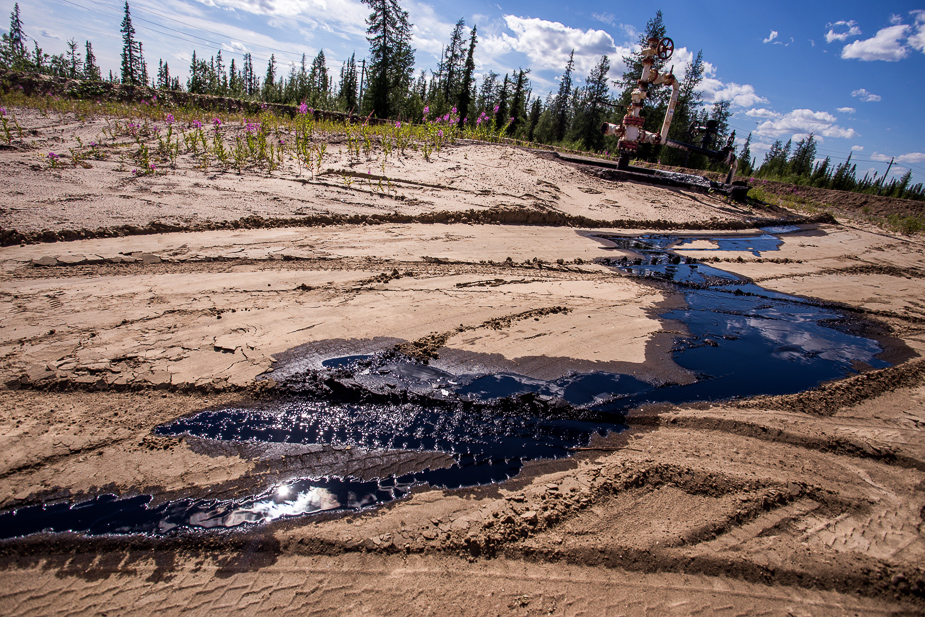
'This well does not work, but is not conserved, so it flows,' Yablokov says. 'Now we are on one of the pads of the Usinsk deposit of "Lukoil-Komi". We see drops of oil leaking out of the well, and a puddle. It is a violation of fire safety. In the forests this oil affects the environment anyway, which is an environmental violation.'
'In fact, oil is poured within the area of the mining companies, and there are no violations, exсept air pollution,' says Ivan Ivanov.
While we check the well, Elena Sakirko is speaking to someone on the phone. It turns out that Usinsk administration called the Greenpeace Moscow office. Officials are concerned that they had not been warned of the blog tour.
Up next is an area where oil had spilled into several hectares. On the site of the spillage we had had to cut down the entire forest and dig drains. Two years ago, oil leaked here instead of water.
'In fact, oil is poured within the area of the mining companies, and there are no violations, exсept air pollution,' says Ivan Ivanov.
While we check the well, Elena Sakirko is speaking to someone on the phone. It turns out that Usinsk administration called the Greenpeace Moscow office. Officials are concerned that they had not been warned of the blog tour.
Up next is an area where oil had spilled into several hectares. On the site of the spillage we had had to cut down the entire forest and dig drains. Two years ago, oil leaked here instead of water.
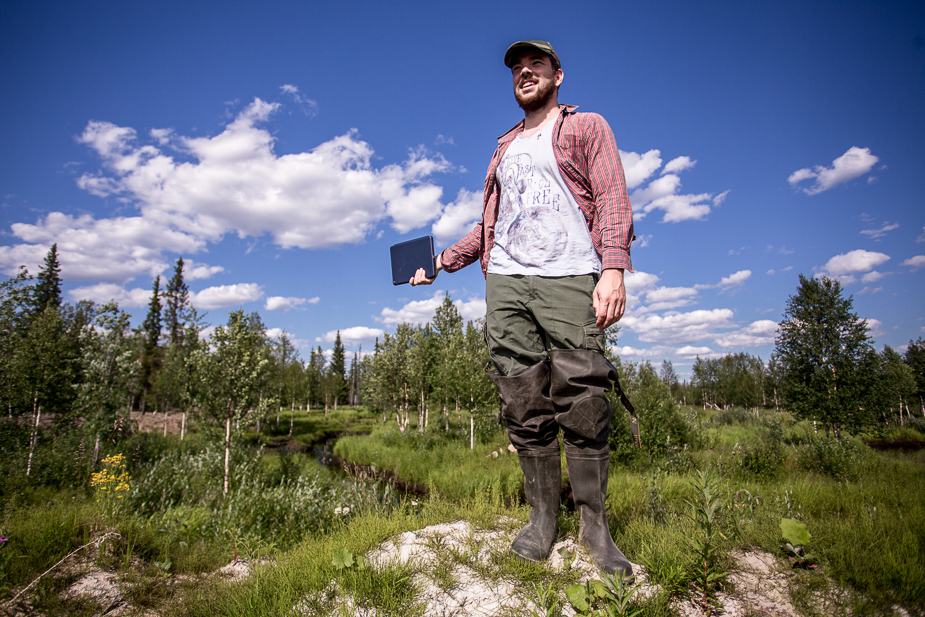
'When we came here a year ago, there were a bunch of employees, mainly from the Central Asian countries,' says Vasily, climbing on a sand mound, 'there was a real old oil field, people scooped oil with shovels, lived here, without safety, even without any personal protective equipment. In July last year work had been well under way, workers had cleaned out corridors. However, in some places even now some oil remains, and the water is still dirty with stains. In October 2015, this site was submitted to the Commission, the work has already been completed, and maybe this year they will try to present it as reсlaimed. But now, I'll show you a very rare object.'
It turns out that the cleaning works were conducted with zeal and remarkable ingenuity: trees which has been blackened by oil were painted white and it is still visible on the trunks. A year ago, this part of the forest was completely white, because they painted not only birches but also spruces
It turns out that the cleaning works were conducted with zeal and remarkable ingenuity: trees which has been blackened by oil were painted white and it is still visible on the trunks. A year ago, this part of the forest was completely white, because they painted not only birches but also spruces
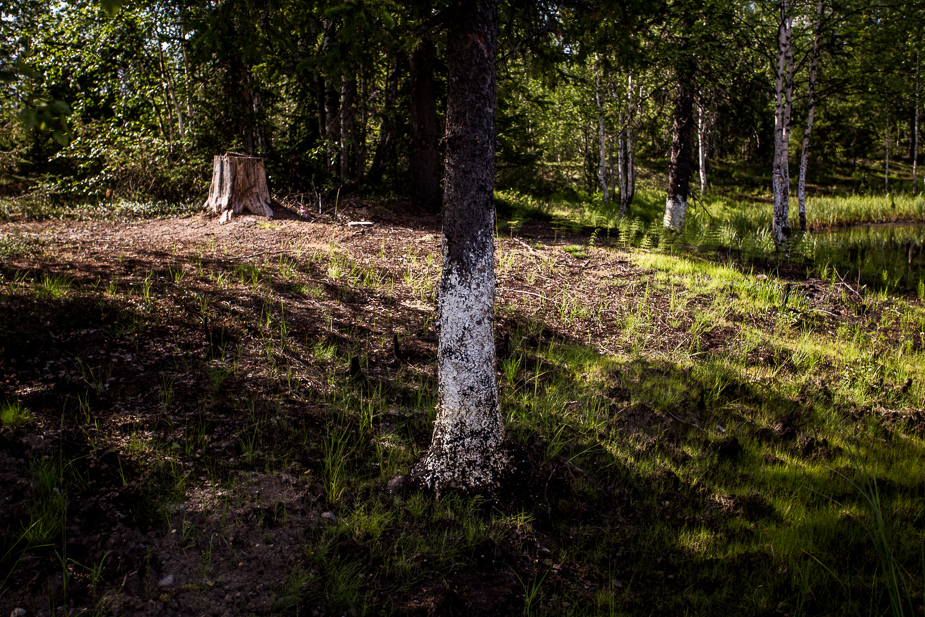
'Surrealism! They simply could not think of anything, but wanted to hide it somehow,' laughs Vasily.
As seen on the trunks, the level of oil was about half a meter. Two years ago, there was an oil lake spread across a few acres and it was one and a half meters deep.
'There is a whole institution – Komimeliovodhoz [Federal State Institution "Department of land reclamation and agricultural water supply in the Republic of Komi"], they evaluate the entire territory, decide what needs to be done, take samples, develop a project on land reclamation. Then contractors, mainly SPASF Nature, reclaim it, and then the commission accepts it as such.
In October 2015, there were still no visible traces of oil, but now it has begun to flow again.
As seen on the trunks, the level of oil was about half a meter. Two years ago, there was an oil lake spread across a few acres and it was one and a half meters deep.
'There is a whole institution – Komimeliovodhoz [Federal State Institution "Department of land reclamation and agricultural water supply in the Republic of Komi"], they evaluate the entire territory, decide what needs to be done, take samples, develop a project on land reclamation. Then contractors, mainly SPASF Nature, reclaim it, and then the commission accepts it as such.
In October 2015, there were still no visible traces of oil, but now it has begun to flow again.
Cleaning of oil spills
The process is divided into three stages. First, the spillage is localized – they make sand backfilling (in fact, it's just a sand mound, preventing the spread of oil or oily liquids). This is followed by the elimination of oil, it is pumped up or dreged. And after that – recultivation, which is held in two stages. Technical is cleaning oil-contaminated soil. Biological is needed to restore fertility: they bring a new layer of soil and seed resistant culture, such as timothy or oat.
The process is divided into three stages. First, the spillage is localized – they make sand backfilling (in fact, it's just a sand mound, preventing the spread of oil or oily liquids). This is followed by the elimination of oil, it is pumped up or dreged. And after that – recultivation, which is held in two stages. Technical is cleaning oil-contaminated soil. Biological is needed to restore fertility: they bring a new layer of soil and seed resistant culture, such as timothy or oat.
'The Minister is interested in us [Minister of Natural Resources and Environmental Protection of the Komi Roman Polshvedkin],' said Ivan Ivanov. 'Well yes, they have nothing to worry about, it's an adopted land [a special committee examined the spill site after recultivation work and, as mentioned above, the site can now be recognized as fully cleared].'
The Ministry also called the head office of Greenpeace Russia. While we are discussing the sudden hype about blogging tour, the car suddenly stops, someone notices a dead bird on the road. We go in for a closer look.
The Ministry also called the head office of Greenpeace Russia. While we are discussing the sudden hype about blogging tour, the car suddenly stops, someone notices a dead bird on the road. We go in for a closer look.
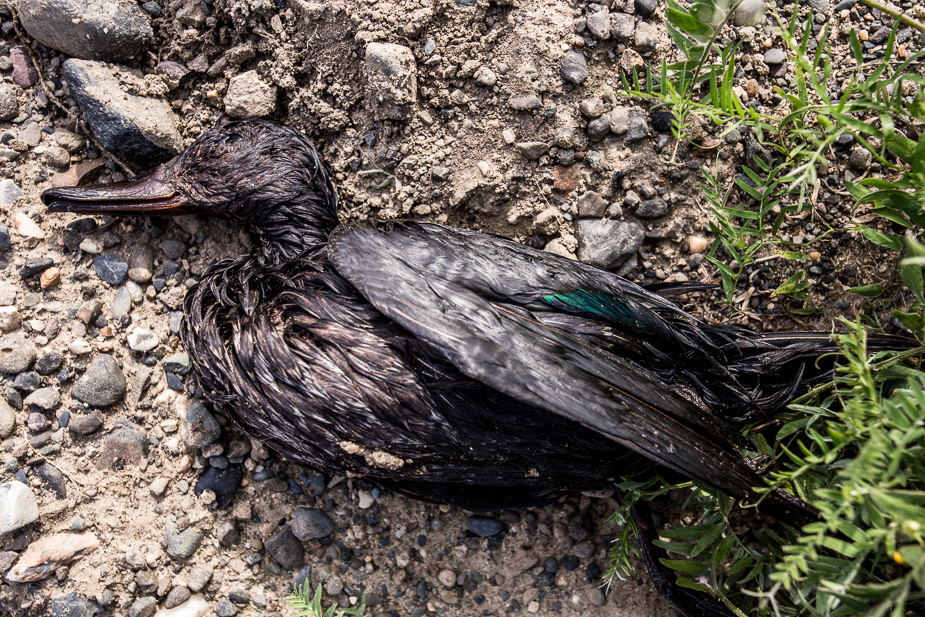
'Looks like teal,' Ivan Ivanov says. 'It is usually gray.'
Ivan touches his feathers and beak, there is something black on his the fingers, it smells and looks like oil.
After passing a little more, we stop again – Vasily notices traces of reclamation. Behind a fresh dumping of sand there is another oil spill.
'How many of them are there here?' I ask the driver.
'Oh!..' he exclaims looking up.
'If you see the fresh sand, you have an 80 percent probability that there is an oil spill,' Ivanov explains.
Finding a fresh spill is a good reason to learn how to fix them. Vasily Yablokov gives everyone special forms and shows them how to fill them in: it is necessary not only to specify the location, but also to describe the terrain, the nature of the oil spill, as well as highlight the main violations.
The spill is small – there are small puddles with iridescent spots behind the bulk. It seems almost innocuous, but a dead bird displays quite the opposite.
The next spillage seems to be a whole lake of oil. Probably it is. Strange, but this picture is fascinating.
Ivan touches his feathers and beak, there is something black on his the fingers, it smells and looks like oil.
After passing a little more, we stop again – Vasily notices traces of reclamation. Behind a fresh dumping of sand there is another oil spill.
'How many of them are there here?' I ask the driver.
'Oh!..' he exclaims looking up.
'If you see the fresh sand, you have an 80 percent probability that there is an oil spill,' Ivanov explains.
Finding a fresh spill is a good reason to learn how to fix them. Vasily Yablokov gives everyone special forms and shows them how to fill them in: it is necessary not only to specify the location, but also to describe the terrain, the nature of the oil spill, as well as highlight the main violations.
The spill is small – there are small puddles with iridescent spots behind the bulk. It seems almost innocuous, but a dead bird displays quite the opposite.
The next spillage seems to be a whole lake of oil. Probably it is. Strange, but this picture is fascinating.
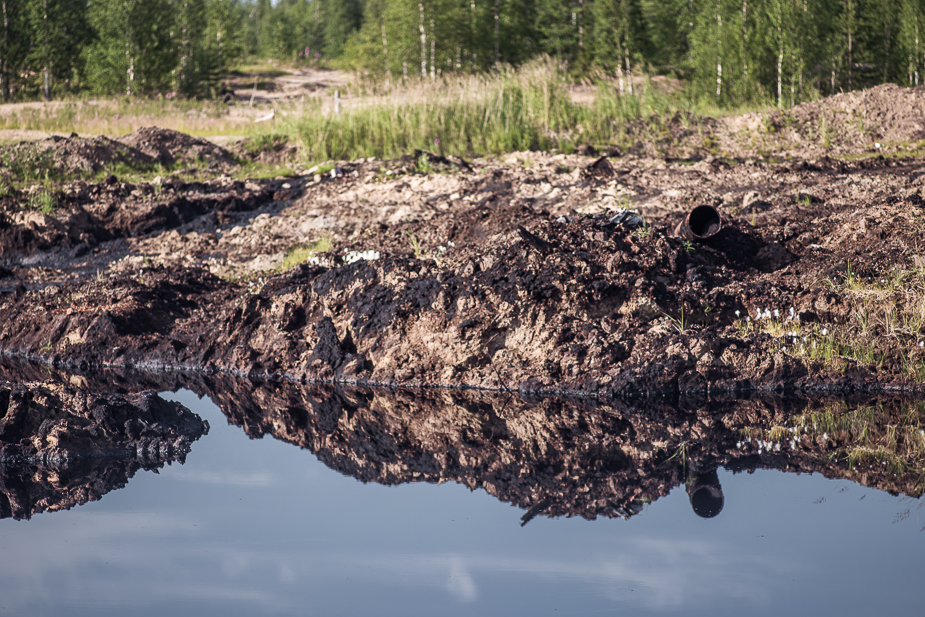
'Oil has a very good reflective effect,' says Ivan Ivanov, and then explains: 'I focus on these kind of things in order to not get upset.'
Vasily throws a stone into the lake, the oil is thick.
'And in the 90's such lake would have set alight,' says Ivan, 'and there would be the black column of smoke, so thick that it would seem that you could touch it.'
We are on a hill of sand poured around a spillage. Vasily offers to move on so as not to breathe in the fumes of oil as it can really make your head spin.
At the site of the next oil spill he shows us some photos and finally looks happy:
'It looked like this a year ago.'
A photo of widely spilled oil. Now after restoration we can see grass growing in some places.
A little further – a swamp. On the edge of it some sand has been dumped. Ivan, who had been here before, suggests that contaminated soil hasn't been excavated and that the oil has just been covered with sand and grass has been planted in it.
At the end of the trip we stop at the station where the Greenpeace patrol had been involved in collecting the spilled oil two years ago.
'We had pumps, and even boat,' says Vasily, 'we worked in two shifts.'
Vasily throws a stone into the lake, the oil is thick.
'And in the 90's such lake would have set alight,' says Ivan, 'and there would be the black column of smoke, so thick that it would seem that you could touch it.'
We are on a hill of sand poured around a spillage. Vasily offers to move on so as not to breathe in the fumes of oil as it can really make your head spin.
At the site of the next oil spill he shows us some photos and finally looks happy:
'It looked like this a year ago.'
A photo of widely spilled oil. Now after restoration we can see grass growing in some places.
A little further – a swamp. On the edge of it some sand has been dumped. Ivan, who had been here before, suggests that contaminated soil hasn't been excavated and that the oil has just been covered with sand and grass has been planted in it.
At the end of the trip we stop at the station where the Greenpeace patrol had been involved in collecting the spilled oil two years ago.
'We had pumps, and even boat,' says Vasily, 'we worked in two shifts.'
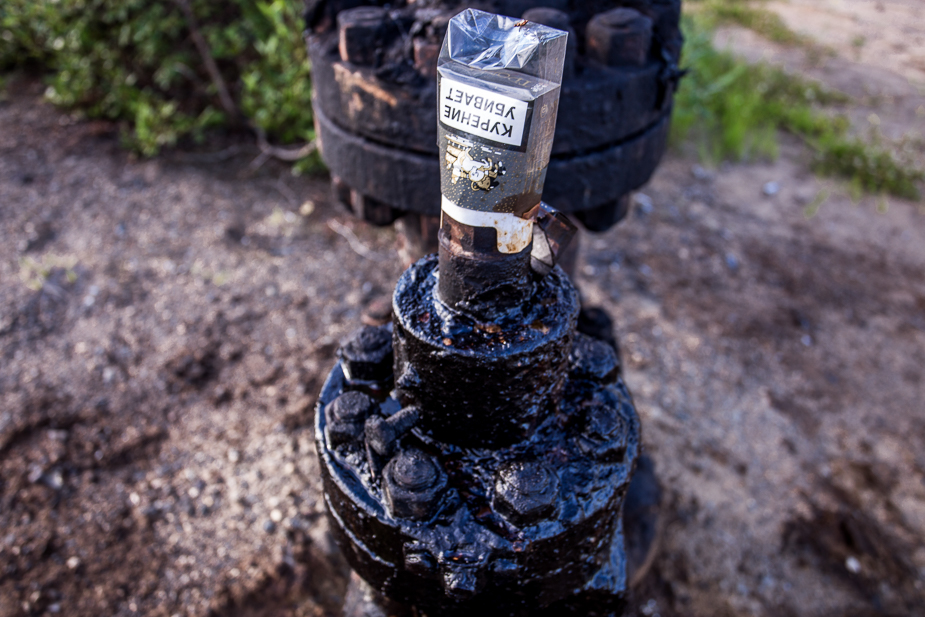
Then, they managed to remove 20 tons of oil, but there was much, much more. I step to one and overhear the conversation of our drivers:
'There was a pit as tall as a man; I remember how I brought some people here, saying that they would help, that everything would be removed, they arrived with bags. I walked away to buy juice, came back, and they had just filled it up with soil!'
'Yes, it is clear that they didn't clean anything at all,' nods his colleague.
Now, there is not a trace left, grass is growing through the ground. Lena and Vasily from Greenpeace are tireless: take out some shoes from the boot of the car, move through the former overflow area and walk on. They are joined by a few people. Near the place where reclamation was carried out we found a new spillage.
We returned to the city and hour later than planned. And this is despite the fact that we hadn't visited all the sites we planned to see. One of the sites could not be reached because gates had been placed at the entrance.
In the city, I notice tattoo with the letter A on hand of our driver.
'What is your name?' I finally ask.
'Alexander. Good luck to you in this difficult matter,' the driver very seriously looks at me and nods.
'And to you,' I say, thinking that it is our common cause. A little pretentious thought. But in fact it is true.
To be continued.
'There was a pit as tall as a man; I remember how I brought some people here, saying that they would help, that everything would be removed, they arrived with bags. I walked away to buy juice, came back, and they had just filled it up with soil!'
'Yes, it is clear that they didn't clean anything at all,' nods his colleague.
Now, there is not a trace left, grass is growing through the ground. Lena and Vasily from Greenpeace are tireless: take out some shoes from the boot of the car, move through the former overflow area and walk on. They are joined by a few people. Near the place where reclamation was carried out we found a new spillage.
We returned to the city and hour later than planned. And this is despite the fact that we hadn't visited all the sites we planned to see. One of the sites could not be reached because gates had been placed at the entrance.
In the city, I notice tattoo with the letter A on hand of our driver.
'What is your name?' I finally ask.
'Alexander. Good luck to you in this difficult matter,' the driver very seriously looks at me and nods.
'And to you,' I say, thinking that it is our common cause. A little pretentious thought. But in fact it is true.
To be continued.
Text by Elena Solov'eva

